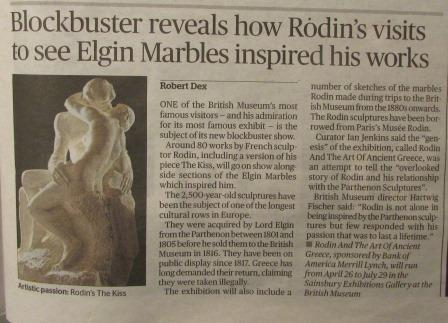The French artist, Auguste Rodin drew inspiration from the headless ancient sculptures. The Parthenon Marbles were his favourite works of art during his 15 visits to the British Museum from 1881 to 1917. Yet this is no argument for the British Museum's director Hartwig Fischer to justify retaining the sculptures from the Parthenon in the British Museum.
The new exhibition Rodin and the Art of Ancient Greece (26 April – 29 July 2018) at the British Museum may place the sculptures 'in the context of world cultures' but does not justify the BM's refusal to allow Athens to display the surviving pieces as united as possible, and with views to the Parthenon itself.
'Although the marble stonework of the Parthenon had proven its durability against the ravages of time, it was not indestructible. In 1687, Venetian forces laying siege to Athens shelled the ancient city, igniting a powder magazine stored inside the Parthenon. The resulting explosion was catastrophic, obliterating the cella and the elaborate frieze that had adorned its exterior. Attempts by the Venetians to remove statues from the pediments were similarly disastrous, as multiple sculptures fell to the ground and were shattered beyond repair. Most of the remaining statues and reliefs (known as the "Elgin" or "Parthenon Marbles") were later spirited away in the early 19th Century by Lord Elgin, the British ambassador to the Ottoman Empire. Controversially, these pieces are displayed in the British Museum to this day. Meanwhile, the Parthenon itself has since undergone rigorous restoration and preservation work, with much of the damaged peristyle reassembled to give modern visitors a glimpse of the temple's ancient splendour atop the hill where it has stood for over two thousand years.'
If understanding world culture also means understanding history's mistakes, then (where possible) putting right old wrongs can promote cultural and international relations. Reuniting the Parthenon Marbles in Athens ought to be a possibility that supports world cultures for all the right reasons and promotes greater understanding, respect and compassion.
We are certain that Rodin's exhibition at the British Museum will be exquisite and enjoyed by many, however it can never replace the sheer inspiration that would be enjoyed, by many more, if we could hope to see the surviving sculptures reunited in the superlative Acropolis Museum.
Hartwig Fischer, director of the British Museum, is also quoted as saying that although other artists had been inspired by the Parthenon sculptures, Rodin had responded "with a passion that was to last a lifetime". The passion and love for the Parthenon Marbles felt by millions of Acropolis Museum visitors will continue forever. A Rodin's exhibition at the British Museum would be equally possible with a loan from Athens to London too.
Whilst the BM might be trying to recontextualize the sculptures from the Parthenon, a building which still stands - it will never erode the natural thirst of millions of visitors to the Acropolis Museum, hoping to see the unity of this peerless work of art.
Letter from the Greek Ambassador, H E Dimitris Caramitsos-TzirasDimitris Caramitsos-Tziras to Hartwig Fischer, Director of the British Museum, 25 April 2018.
More articles on this include:
British Museum claims French artist Rodin proves why Parthenon Marbles should stay in Britain
Rodin's work to go on show in London next to Parthenon marbles
Rodin's love of the Parthenon sculptures revealed
Article in the Evening Standard and letter from Chair of the BCRPM to the Evening Standard

Letters Page Evening Standard:
Dear Sirs,
I write as Chair of the British Committee for the Reunification of the Parthenon Marbles, to remind interested parties that although Rodin was much excited by the sculptures he saw in the Museum, and found them inspiring, he nevertheless lamented their exile from the sweet Attic sunlight beloved of Homer: "Toutes les lumières électriques n'ont pas la force de les empêcher de rechercher éternellement la douce lumière d'Homère".
Those sculptures, which we prefer to attribute to the Parthenon from whence they were grabbed rather than to Elgin the grabber, should now be relinquished back to the city they once crowned. They have inspired artists and thrilled the curious in their gloomy rooms in Bloomsbury for long enough and now the country of their origin deserves their glory, in the museum built especially to house them facing the Acropolis and the still miraculously upright building that they once adorned.
Yours sincerely,
Janet Suzman DBE
London NW3 2RN